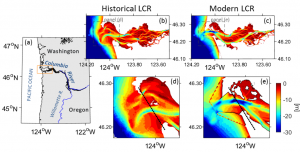
Impact of estuary outlet modifications on large-scale river plumes
Member
Description
Nearly all major river outlets in the US (and the world) have been modified, and this research project examines the impact of the historical modifications (jetty construction, dredging, and reservoir management) to the Lower Columbia River Estuary (LCRE) on the mixing and structure of the Columbia River plume (CRP) and, ultimately, the freshwater dispersal in the coastal ocean on a regional-scale. To analyze the impacts of estuarine outlet modifications, we are utilizing existing “historical” and “modern” numerical models of the LCRE, which have been developed and calibrated using 19th and 21stcentury bathymetry and tide data. Peak flows for the LRCE have been reduced by 40-50%, outlet width halved, and outlet depth tripled in the past 150 years, which we hypothesize fundamentally alters basic plume characteristics – hydraulic control at the outlet, mid-field plume size, stratification, plume entrainment rates, and interaction with upwelling winds.
The effects of anthropogenic alterations to the LCRE are also important in the context of climate change: historical changes to river flow and depth provide a template for understanding future changes due to sea-level rise and altered hydrological patterns. This project will be a critical step in advancing the knowledge of the human-induced impacts on the OR/WA coast while simultaneously addressing fundamental questions on the role of outflow controls on plume structure and transports as it spreads and evolves on the continental shelf.
